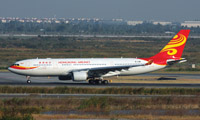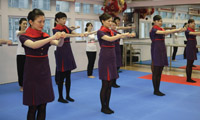News Feature
Chinese passengers seeing red
While air rage is declining in most parts of the world, it is a growing problem in China. Yet most authorities and airlines don’t seem prepared to take firm action to control the trend.
June 1st 2013
When mining executive and Chinese Communist Party official, Yan Linkun, missed his flight at Kunming Changshui International Airport in February, he was not a happy man. Read More »
 |
| 'When flights get delayed, passengers make a lot of trouble. Sometimes they even beat our staff … the only thing we can do is to give them compensation to calm them down' |
| Wang Zhenghua Chairman Spring Airlines |
Yan screamed abuse at staff, smashed two airline boarding gate computers and tried to force his way through a closed glass door barring his way to the flight line. Surprisingly, security and airline staff took no action to stop him.
CCTV footage of the incident, which went viral on YouTube, drew global attention to a problem that has reached serious proportions in China: air rage both inflight and on the ground. It has become so prevalent a new phrase, kong nu zu or ‘air rage tribe’, has been coined to describe those involved.
While no official statistics are available, air rage instances are now being reported on an almost weekly basis as angry passengers react violently to such things as delayed and cancelled flights in China’s crowded skies.
The Kunming temper tantrum was no isolated incident.
Yet in nearly all cases of air rage, no action is taken against those involved. Indeed, passengers who complain are often rewarded with compensation.
For instance, 20 disgruntled passengers stormed a runway at Shanghai Pudong International Airport in April last year protesting about a 16-hour flight delay. They came within 200 metres of a jet arriving from the United Arab Emirates, but each was given 1,000 yuan (US$162) in compensation.
More recently, in March, a Hong Kong Airlines flight was grounded for six hours at Hainan’s Sanya Airport. Four hours into the delay, an elderly man rushed into the business class cabin and started to physically and verbally attack a stewardess.
Many of his fellow passengers began to cheer and applaud. The attacker was finally pulled away by two western businessmen travelling on the flight.
While many airlines, particularly in China, are reluctant to talk in detail about such events, the proliferation of such incidents is no secret.
 |
| 'People, particularly those in an official capacity, are standing back instead of doing their job' |
| Dr. Vernon Nase Head of the Department of Law Curtin University in Perth, Western Australia |
Indeed, the trend was underscored last year when Wang Zhenghua, founder and chairman of Shanghai-based budget carrier, Spring Airlines, disclosed the carrier was dealing with three air rage events a week.
“When flights get delayed, passengers make a lot of trouble. Sometimes they even beat our staff. Airlines are the [innocent] party. With the government calling for a ‘harmonious society’, the only thing we can do is to give them compensation to calm them down,” he said.
Much of the blame for the lengthy flight delays in China is directed at the military, which controls 80% of the airspace. While Beijing has moved to make its air traffic system more efficient and free up more military airspace, it remains a serious issue and is a major contributor to congestion.
More than 270 million passengers flew on domestic routes in China last year, up nearly 10% on 2010 and 70% over 2003.
The International Air Transport Association (IATA) has forecast 379 million people will be flying domestically in China by next year. And with airlines expanding fleets to keep pace with demand, there is little prospect of the delay situation easing. Boeing has predicted China will need 5,260 new aircraft, worth $670 billion, in the next 20 years.
According to the Civil Aviation Administration of China (CAAC), about a quarter of the 2.4 million domestic flights in the country were delayed in 2011. Last year, is understood to have been far worse.
But while delays are a major cause of air rage incidents, many industry analysts and observers believe there are deeper issues which need to be addressed.
Dr. Vernon Nase, head of the department of law at Curtin University in Perth, Western Australia, said cultural elements also contributed to the situation. “It’s a mixture of issues. It’s like pouring a few things into a hot pot and stirring them,” he said.
“There is a view, particularly in the PRC (People’s Republic of China), that a harmonious society needs to be maintained and they don’t want to have incidents that roll into the public domain.
 |
| Hong Kong Airlines: passengers applauded when flight attendant was attacked during flight delay |
“That has resulted in reluctance to deal with conflict situations. People, particularly those in an official capacity, are standing back instead of doing their job.”
Nase, who taught at City University in Hong Kong before moving to Australia in January, has studied air rage around the world. He told Orient Aviation that the way Chinese aviation law was written in relation to air rage, appeared “to be almost dumbed down”.
In Hong Kong, the aviation security ordinance was specific in terms of dealing with incidents in Hong Kong airspace, he said. “It is consistent with what you’d expect in most countries in that it gives the pilot in command appropriate powers to ensure the good safety and order and discipline that occurs onboard. They can have people restrained in order to maintain good order,” said Nase.
However, he suggested the “indirect way” in which the Chinese civil aviation law was written made it unclear for flight crews to know how to respond to certain situations.
While it says the captain and crew should “do their work conscientiously” to ensure the safety of the aircraft and the people and property on board, the wording “just seems to be almost dumbed down and neutralized to some extent”, said the professor. The attitude was “yes, there’s an obligation, but we’re going to express it in a very watered down kind of way,” said Nase.
“China needs to look at people’s roles and how they deal with air rage. It needs to do some basic re-writing of its laws.
| Tougher penalties ‘working’ Air rage in the U.S. is declining and the reason for this, say insiders, is the introduction of tougher penalties for unruly behaviour. U.S. Federal Aviation Administration (FAA) statistics show incidents of air rage, which led to action being taken, peaked in 2004 at 330. The figure has been declining in the last eight years and dropped to 101 in 2012. Anecdotal reports suggest that while air rage is still a problem in Europe, instances have also been declining there. |
“The wording in the law needs to be toughened up. Express references should be made to incidents on board and what is the expectation of the aircrew.
“It should be set up so that, as in most countries, if there is an incident the pilot in command can issue orders for the person to be restrained.”
Nase said that if some of the Chinese mid-air incidents had occurred elsewhere in the world, the airline would have diverted and landed at the first available airport.
“There are many incidents of airlines diverting and people being off-loaded and then charged,” he said. “It just seems to me that there isn’t that sense of ‘we should deal with this’. That is not appropriate when you have got such a potential for disaster.”
Nase and industry insiders all agree that giving compensation is self-defeating. There have been suggestions in the Chinese media that some of the incidents have occurred because people expect to receive money for their actions.
Kung fu training puts flight crews on their toes
 |
Faced with increasing cases of air rage on China’s air routes some airlines are preparing their cabin crew to deal with the tricky situations.
Hong Kong Airlines has made it compulsory for flight attendants to be trained in wing chun, a form of kung fu that dates back to the Qing Dynasty (1644-1911).
All crew get six hours training in the ancient martial art (photo right).
A spokesman for Hong Kong Airlines said the martial art classes were “to boost health and improve body strength to give crews more confidence in dealing with emergencies on planes.”
Cabin crews elsewhere are no strangers to going through some form of training to prepare them for air rage or other violent incidents. Major airlines around the world – both flight attendants and cockpit crew – are given emergency procedures training, include lessons on dealing with such things as hijackings, violent behavior or drunk passengers.
Airlines usually carry restraining straps or handcuffs on board. The decision to use them is in the hands of the flight captain.
| More air rage incidents: August 2012: Two passengers who had been refused compensation for a flight delay opened an emergency exit door on their plane resulting in a further delay. October: An Australian pilot and his crew were surrounded and threatened by angry passengers after a Jetstar flight, which had originated in Melbourne, was diverted to Shanghai because of bad weather. January 2013: Thousands of angry passengers were stranded after heavy fog delayed more than 280 flights at Changshui International Airport in the southern Chinese city of Kunming. Angry passengers struggled with airline staff, damaging computer equipment belonging to an airline, while police broke up scuffles. February: At Beijing Capital International Airport six business class passengers travelling together refuse to fasten their seat belts or turn off their phones prior to takeoff, then become abusive toward the flight attendants and the captain, forcing a return to the gate and a substantial flight delay. February: At Guangzhou Baiyun International Airport flight delays on a Melbourne-bound flight of China Southern AIrlines resulted in two Chinese passengers beating an employee to the ground. February: On an Air France flight between Paris and Wuhan two men, reportedly drunk, stole between seven and 16 bottles of wine (accounts vary) from a drink cart. They threatened a passenger who asks them to stop. When confronted, they become so belligerent that the pilot has to intervene. |